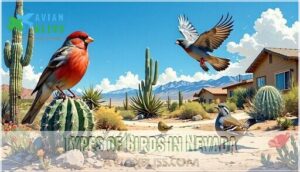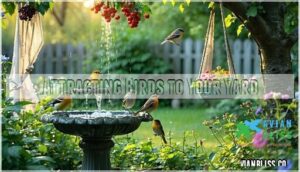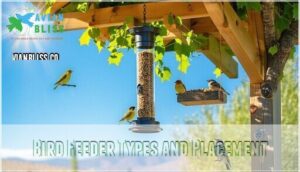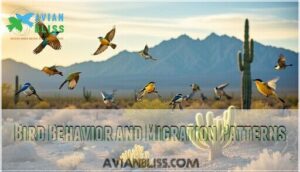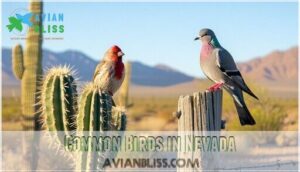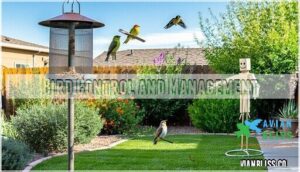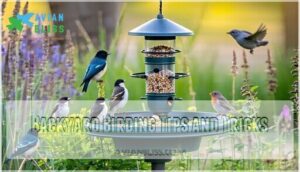This site is supported by our readers. We may earn a commission, at no cost to you, if you purchase through links.
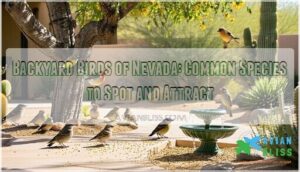
You’ll spot sparrows and finches like the House Finch or White-crowned Sparrow, vibrant American Goldfinches, and flocks of Mourning Doves. Keep an eye out for the flashy feathers of Western Scrub-Jays or Northern Flickers.
In spring, warblers brighten things up, while chickadees and nuthatches often stay year-round. Each brings its own charm and habits to observe.
Attract these birds with native plants, seeds like sunflower or millet, and water sources. Creating a bird-friendly space helps them thrive—and might bring some surprise visitors to your yard, too!
Table Of Contents
- Key Takeaways
- Identifying Backyard Birds
- Types of Birds in Nevada
- Attracting Birds to Your Yard
- Bird Feeder Types and Placement
- Bird Behavior and Migration Patterns
- Bird Conservation and Safety
- Common Birds in Nevada
- Bird Control and Management
- Backyard Birding Tips and Tricks
- Frequently Asked Questions (FAQs)
- How do I identify a bird in my backyard?
- What birds live in the Nevada desert?
- What is killing birds in my backyard?
- What bird is Nevada known for?
- What is the most common bird in Nevada?
- How can I identify a bird in my yard?
- What is the most common backyard bird?
- What kind of birds does Nevada have?
- Is it good to have birds in your yard?
- Where have all the backyard birds gone?
- Conclusion
Key Takeaways
- Attract birds by planting native plants, setting up feeders with diverse seeds like sunflower or millet, and providing water sources like birdbaths.
- Identify common backyard birds like Mourning Doves, House Finches, and Yellow Warblers by their colors, size, and unique behaviors.
- Protect birds by avoiding pesticides, keeping cats indoors, cleaning feeders, and using UV decals to prevent window collisions.
- Watch for migration patterns, noting seasonal visitors like warblers and creating a welcoming stopover with safe shelter and fresh water.
Identifying Backyard Birds
You can spot Nevada’s backyard birds by paying attention to their size, color patterns, and unique features like beak shape.
Learning to tell apart males, females, and juveniles makes identification even easier.
Common Bird Species in Nevada
Nevada’s backyards are buzzing with birdlife, making it a paradise for birdwatchers. Some of the most common backyard birds in Nevada are easy to spot and enjoy.
- Mourning Dove: With its soft coo and sleek, gray-brown feathers, this gentle bird is a year-round favorite.
- House Finch: These cheerful, red-headed songbirds love sunflower seeds and flock to feeders.
- Mountain Bluebird: Nevada’s state bird, its bright blue feathers light up open spaces.
- Gambel’s Quail: Ground-dwelling charmers with distinctive topknots, often seen scurrying in groups.
These common backyard birds make Nevada birdwatching a simple, rewarding experience right at home.
Bird Identification by Color
Learning bird identification by color makes spotting Nevada’s backyard birds a breeze.
Use these clues to identify Nevada birds like a pro!
Red bird identification? Look for the American Robin’s rusty-red chest.
Yellow bird identification? Lesser Goldfinches flash bright yellow.
Blue bird identification? The Mountain Bluebird stands out.
Brown bird identification? Mourning Doves sport soft brown feathers.
Black bird identification? Check for Red-winged Blackbirds with striking red-and-yellow wing patches.
Recognizing Male, Female, and Juvenile Plumages
Spotting Male vs Female and Juvenile Plumage in Nevada birds can be fun and fascinating. Males often flaunt bright feathers, while females stick to muted tones for camouflage. Juveniles? They’re like teenagers—awkward, with softer, less defined patterns.
- Age differences show in feather texture and color.
- Seasonal changes bring molting patterns, altering plumage.
- Common Nevada birds like House Finches highlight these traits.
- Backyard bird identification gets easier once you know what to watch for!
Tips for Identifying Less Distinctive Birds
Identifying less distinctive birds can feel like solving a backyard mystery.
Start with plumage variations—even subtle differences in feather patterns or tail lengths can be key. Pair this with behavior observation: how does the bird perch or move?
Use habitat clues to narrow it down; certain birds favor specific spots.
Don’t forget vocalizations—unique calls often reveal species. For example, similar species like sparrows can be distinguished by their chirps.
With these Nevada backyard birding tips, your bird identification guide becomes sharper, even for the trickiest common Nevada birds!
Types of Birds in Nevada
Nevada’s backyard birds come in all shapes and sizes, from tiny finches to larger doves and hawks.
You’ll spot everything from colorful songbirds like the House Finch to ground-loving species like the Gambel’s Quail.
Sparrows, Finches, and Their Allies
Sparrows and finches bring life to your yard with their lively antics and bright colors. With the right seeds, your yard becomes a hotspot for these feathered visitors.
The House Finch diet includes sunflower seeds and nyjer, making finch feeders a must-have.
For sparrow identification, look for the bold black-and-white head of the White-crowned Sparrow or the streaky plumage of the Song Sparrow.
Lesser Goldfinch behavior often involves playful flocks, while Pine Siskin migration peaks in winter.
Doves, Mockingbirds, and Starlings
Nevada’s backyard birds include some fascinating species.
- Mourning Doves: Known for their soft coos, their dove plumage is grayish-brown, and their dove diet includes seeds on the ground.
- Northern Mockingbirds: Famous for their mockingbird songs, they mimic other birds effortlessly.
- European Starlings: Watch their dazzling starling murmurations near starling roosts.
- Brown-headed Cowbirds: These feeder visitors prefer platform feeders and often surprise with their unique habits.
Jays, Crows, and Woodpeckers
Nevada’s backyard birds include some fascinating characters. The California Scrub-Jay and Woodhouse’s Scrub-Jay bring vibrant blues to your yard.
The Pinyon Jay prefers wooded areas.
Northern Flickers and Downy Woodpeckers keep busy hammering for insects, creating rhythmic sounds. Meanwhile, the Common Raven and Steller’s Jay show off their smarts, often stealing the spotlight.
| Bird | Size | Behavior | Habitat |
|---|---|---|---|
| Scrub Jay | Medium | Bold, curious | Open woodlands |
| Northern Flicker | Large | Drums on trees | Suburban areas |
| Downy Woodpecker | Small | Pecks for insects | Backyard feeders |
| Common Raven | Large | Highly intelligent | Urban and rural |
Thrushes, Chickadees, Wrens, and Warblers
Thrush Identification starts with spotting the American Robin, with its orange-red breast and cheerful song.
Chickadee Habitats, like those of the Mountain Chickadee, include wooded backyards where suet feeders thrive.
Bewick’s Wren Behaviors often involve energetic hopping and bold calls.
Warbler Migration brings the Yellow-rumped Warbler and Ruby-crowned Kinglet to your yard in winter. Nevada’s Mountain Bluebird prefers open spaces, but native plants can make your yard irresistible to these delightful visitors.
Attracting Birds to Your Yard
You can attract more birds to your yard by offering the right mix of food, water, and shelter.
Setting up feeders, planting native plants, and adding a birdbath creates a welcoming space for Nevada’s feathered visitors.
Choosing The Right Bird Feeder
Choosing the right bird feeder for your Nevada backyard makes birdwatching more rewarding. Nevada backyard birders can purchase Nevada bird feeders online.
Start with durable feeder materials like metal or thick plastic to handle the desert’s tough winds. Proper feeder placement—away from predators and near shrubs—keeps birds safe.
Match feeder size to species; small ones suit finches, while platforms attract larger birds. Don’t forget a cleaning schedule to prevent disease. For extra fun, try squirrel-proofing your setup to keep the seeds for your feathered guests.
- Sturdy materials guarantee long-lasting feeders.
- Strategic placement boosts bird activity.
- Size variety invites diverse species.
- Regular cleaning keeps feeders safe.
- Squirrel-proofing saves your birdseed.
Selecting Birdseed and Suet
Your bird feeder’s success hinges on the right seed types and suet options. Black-oil sunflower seeds are a favorite for finches and sparrows, while nyjer seeds attract goldfinches. For woodpeckers, suet is a winter must-have.
Keep seeds fresh by storing them in airtight containers. You can find the best birdseed in Nevada from specialized retailers.
Here’s a quick guide:
| Bird | Seed Types | Suet Options | Feeder Choices |
|---|---|---|---|
| House Finch | Sunflower, Nyjer | Not preferred | Tube, Hopper |
| Mourning Dove | Mixed Seeds, Millet | Not preferred | Ground, Platform |
| Northern Flicker | Sunflower, Peanuts | High-fat Suet | Suet Cage |
| Goldfinch | Nyjer, Sunflower | Not preferred | Nyjer Feeder |
Smart placement tips and seasonal variety guarantee your Nevada bird feeders keep attracting birds year-round!
Providing Water Sources for Birds
Every backyard needs a water source to attract birds in Nevada’s dry climate. Keep it simple and effective:
- Use shallow bird baths with gentle slopes for easy access.
- Add drippers or misters to mimic natural water sources.
- Prioritize bird bath hygiene by cleaning weekly to prevent bacteria.
Providing shallow water year-round guarantees your yard becomes a favorite stop for backyard birds. Fresh water’s the real desert oasis!
Planting Native Plants for Bird Habitat
After setting up water sources, it’s time to think about creating a backyard bird habitat using native plants. Native plants offer food sources, shelter, and nesting spots while saving water—a win-win for you and Nevada’s birds.
Think of your yard as a buffet and hotel for local bird species like sparrows and hummingbirds.
Here’s a quick guide:
| Plant | Benefit | Bird Species Attracted |
|---|---|---|
| Desert Willow | Nectar Source | Hummingbirds |
| Sagebrush | Shelter, Seeds | Sparrows |
| Rabbitbrush | Late-Season Blooms | Pollinators and Songbirds |
These planting strategies support biodiversity and help attract birds Nevada calls home. Your yard becomes a bird-friendly oasis!
Bird Feeder Types and Placement
Choosing the right bird feeder and placing it correctly can make your yard a hotspot for Nevada’s feathered visitors.
From platform feeders to tube styles, each type attracts specific birds, so it’s worth knowing what works best and where.
Platform Feeders and Hopper Feeders
Platform and hopper feeders are perfect for attracting Nevada’s backyard birds like sparrows, robins, and finches. They’re practical, offering flat surfaces and weather protection to keep birdseed fresh.
To make the most of these feeders, follow these tips:
- Minimize seed spillage by not overfilling.
- Limit squirrel access with baffles or squirrel-proof designs.
- Choose proper mounting options for stability and visibility.
- Opt for larger feeder capacity to reduce frequent refilling.
- Place feeders in safe spots with nearby cover for birds to perch.
These feeders create a welcoming space for common backyard birds while keeping maintenance simple.
Tube Feeders and Nyjer Feeders
Tube feeders are perfect for attracting Nevada’s finches, especially the bright House Finch and Lesser Goldfinch. These feeders are slim, practical, and a favorite for Nyjer seed benefits. Consider various bird feeder types for attracting a wider range of species.
To make the most of your feeder:
- Tube Feeder Placement: Hang it where squirrels can’t reach.
- Keep birdseed fresh and dry to avoid mold.
- Clean weekly for healthy Finch feeding.
- Use mixed seeds to keep backyard birds curious.
- Add Squirrel Deterrents like baffles for extra protection.
With proper feeder maintenance, your backyard becomes a hotspot for finches and other seed-loving species.
Ground Feeders and Birdbaths
Ground-feeding birds like robins love scattered seeds paired with a clean Nevada bird bath. You can find a variety of Nevada bird bath products online.
Prioritize birdbath hygiene—scrub regularly to prevent bacteria. Place feeders and water sources in shaded spots for predator protection and comfort.
Use the table below to choose the best setup for your backyard birds.
| Feature | Benefit | Placement Tips | Best Birdseed Nevada |
|---|---|---|---|
| Ground Feeders | Attract robins, doves | Shade, near cover | Millet, sunflower |
| Birdbaths | Hydration, bathing | Level ground, partial sun | Fresh water daily |
| Seed Mixes | Variety of species | Scattered near feeders | Blend for sparrows |
| Predator Barriers | Bird safety | Add low shrubs nearby | N/A |
Tips for Placing Feeders for Optimal Viewing
Want to make your backyard birding in Nevada unforgettable? Smart feeder placement is key!
- Place feeders near shrubs or trees for shelter access and predator protection.
- Keep feeders at eye level for the best viewing distance and birdwatching tips.
- Use shaded spots to prevent bird food from spoiling too quickly.
- Avoid window collisions by placing feeders either 3 feet or over 10 feet from windows.
- Group multiple feeders near birdbaths to create a thriving backyard habitat.
These simple adjustments will transform your yard into a bird paradise!
Bird Behavior and Migration Patterns
Birds in Nevada follow seasonal migration patterns.
Some species stay year-round, while others travel thousands of miles.
Watching their behaviors, like feeding habits and flock movements, can help you identify whether they’re residents or just passing through.
Understanding Bird Migration Patterns
Nevada’s skies host awe-inspiring bird migration events as flocks follow the Pacific Flyway.
Flocks soar across Nevada’s skies along the Pacific Flyway, showcasing nature’s breathtaking migration journeys.
Migration timing plays a big role, with peak activity in May and September. Birds travel south for warmer weather, following the fall migration patterns.
Birds track seasonal cues like temperature changes, using impressive navigation methods. Look out for stopover sites where they rest and refuel.
From winter birds in Nevada’s valleys to summer birds soaring above mountains, birdwatching in Nevada offers exciting opportunities to witness these journeys. It’s nature’s ultimate highway!
Recognizing Resident and Migratory Species
Ever wonder how to spot Nevada’s seasonal residents and migratory birds? By observing key patterns, you’ll discover migration timing and plumage changes.
Many birds follow established migration patterns for survival.
Here’s how to track these backyard birds:
- Record Arrival/Departure Times: Note when specific species, like Dark-eyed Juncos, appear or leave.
- Watch for Behavior: Migratory birds often feed heavily during stopovers.
- Observe Plumage: Seasonal transformations reveal species variations, aiding Nevada bird identification.
These steps reveal the secret lives of resident birds and migratory travelers.
How to Identify Birds by Their Behavior
To crack the code of Nevada backyard bird identification, watch for flight patterns – some glide, others zigzag unpredictably. Listen closely to vocalizations; each chirp adds to your backyard bird identification guide.
Foraging habits reveal preferences, like ground-hopping sparrows. Nesting behavior shows where species call home, while flock interactions highlight social traits.
Observing these bird characteristics transforms your understanding of bird behavior, making each encounter a little mystery to solve.
Tips for Creating a Bird-Friendly Yard
You’ve studied bird behavior—now, make your yard irresistible to Nevada’s backyard birds. It’s simple and rewarding.
Here’s your checklist:
- Plant Native Plants: These provide natural food and shelter. Think trees, shrubs, or grasses.
- Add Water Sources: Bird baths or solar fountains work well for drinking and bathing.
- Optimize Feeder Placement: Place bird feeders in safe, shaded spots with clear visibility.
- Offer Shelter Options: Nest boxes or dense foliage create secure hideouts.
Your efforts will attract diverse, happy birds!
Bird Conservation and Safety
You can help protect Nevada’s backyard birds by making your yard safer and more welcoming.
Keeping predators away and preventing window collisions go a long way in supporting these feathered visitors.
Protecting Songbirds From Predators
Protecting backyard birds from predators in Nevada takes some planning. Cats top the predator list, so keep bird feeders and safe birdhouses elevated.
Consider how protecting endangered birds through conservation benefits all avian species. For hawk awareness, add dense shrubs or trees near feeding spots to provide quick cover.
Raccoons can raid nests, so secure birdhouses with predator deterrents like baffles.
Snakes pose a lesser risk but can be managed with thorny plant borders.
These protective landscaping strategies create a haven where your backyard birds can thrive, free from the threat of common bird predators. protecting endangered birds through conservation
Preventing Bird Collisions With Windows
Window collisions are a serious threat to backyard birds in Nevada, but simple fixes can help.
Make glass safer for birds with these strategies:
- Window films: Apply frosted or decorative films that reduce reflections.
- Decals and markers: Space bird-friendly decals 2-4 inches apart.
- Screens and netting: Install exterior mesh to prevent impacts.
- One-way transparent film: These allow you to see out while birds see a warning pattern.
Move feeders closer to windows, so birds approach at slower speeds.
These easy steps protect Nevada’s common backyard birds!
Reducing Light Pollution and Its Effects
Ever wondered how light pollution affects backyard birds in Nevada? Artificial light disrupts nocturnal wildlife, confusing migratory birds traversing the night sky. Bright city lights mask stars and other natural cues critical for bird migration, turning safe routes into risky challenges.
You can help by making small changes to your backyard:
- Use downward-facing fixtures to minimize Night Sky Brightness.
- Install motion sensors to limit constant illumination.
- Switch to warm-toned bulbs, which reduce artificial light effects.
- Dim unnecessary lights to support healthy bird habitats.
With these light pollution solutions, you’ll create a safer space for Nevada’s night migration.
Creating a Safe Environment for Birds
Keeping backyard birds safe in Nevada means smart planning and a little know-how. By creating this bird-friendly space, you’ll keep your feathered friends thriving year-round.
To prevent window collisions, use UV decals and place bird feeders a safe distance from glass. Minimize night lighting to reduce confusion for migratory birds.
Predator protection is key—plant native shrubs to give birds natural hiding spots. Install bird baths and safe feeders away from open areas where predators lurk.
Stick with pesticide avoidance to keep their food sources safe and healthy.
Common Birds in Nevada
You’ll find Nevada’s backyard birds are a fascinating mix of sizes, colors, and behaviors.
From the bright House Finch to the sleek Mourning Dove, these common species are easy to spot and identify.
Rock Pigeon and Its Habitat
Rock Pigeons, also known as Rock Doves, are some of Nevada’s most familiar backyard birds, thriving in urban spaces. They’ve mastered city living, turning ledges and rooftops into perfect nesting spots.
Their adaptability allows them to survive on a feral pigeon diet of seeds, scraps, and even discarded food. These birds navigate cities with ease, evading predators while creating bustling bird habitats.
- Where they thrive: Rooftops, bridges, and city parks
- What they eat: Seeds, grains, human leftovers
- Why they’re fascinating: Smart, adaptable, and social
Black Birds and Their Characteristics
From the glossy Brewer’s Blackbird with its striking yellow eyes to the bold Great-tailed Grackle, Nevada’s black birds stand out. Great-tailed Grackles are often found in noisy urban flocks.
The Common Grackle impresses with its iridescent feathers, while the Red-winged Blackbird adds vibrant flair with red shoulder patches.
Curious about their habits? These common backyard birds forage for insects and seeds, showcasing diverse behaviors.
| Species | Size (in) | Habitat | Notable Feature | Diet |
|---|---|---|---|---|
| Brewer’s Blackbird | 8–10 | Urban/Suburban | Yellow eyes | Seeds/Insects |
| Great-tailed Grackle | 15–18 | Open areas | Iridescent plumage | Grains/Insects |
| Common Grackle | 11–13 | Fields/Woodlands | V-shaped tail | Fruits/Insects |
| Red-winged Blackbird | 7–9 | Wetlands/Fields | Red shoulder patches | Seeds/Insects |
| Brown-headed Cowbird | 6–8 | Grasslands | Glossy brown (males) | Seeds |
Yellow Birds and Their Identification
Spotting Nevada’s yellow birds feels like finding hidden treasures!
From the vibrant Yellow Warbler to the territorial Lesser Goldfinch, these beauties light up backyards.
Learn bird identification using their plumage and habitats:
- Yellow-rumped Warbler: Bold rump patch.
- Western Tanager: Fiery orange head.
- Wilson’s Warbler: Compact, with a black cap.
- Scott’s Oriole: Striking black-yellow contrast.
- American Goldfinch: Cheerful, sunflower hues.
Other Common Bird Species in Nevada
Nevada’s landscapes bring a diverse mix of common backyard birds you can spot throughout the year. Each bird adds character to your yard while offering insights into Nevada’s unique wildlife.
- Gambel’s Quail: Ground-dwelling birds with distinctive topknots, often seen scurrying in groups.
- Western Meadowlark: Known for their cheerful, flute-like songs and bright yellow bellies.
- Great-tailed Grackles: Bold and glossy blackbirds with striking, piercing calls.
- Eurasian Collared-Dove: Pale, gentle doves adapted to urban environments.
- Black-billed Magpies: Large, striking birds with black-and-white plumage and long tails.
From the cheerful morning melody of meadowlarks to the busy chatter of quail and magpies, these Nevada bird species create an active, vibrant backyard experience.
Bird Control and Management
Sometimes birds can overstay their welcome, crowding feeders or damaging gardens. Managing their activity in your yard helps protect your space while keeping a healthy balance for all wildlife.
Managing Bird Populations in Your Yard
Think of your yard as a bird masterpiece. Use feeder management to guide which birds visit, like choosing your favorite notes in a tune.
Add native plants to support backyard birds and nesting sites, while monitoring invasive species. Predator control helps keep balance.
Here’s a quick breakdown:
| Action | Purpose | Tips |
|---|---|---|
| Feeder Placement | Target species | Use specific seeds |
| Plant Native Shrubs | Shelter/Nesting | Low-maintenance plants |
| Predator Deterrents | Bird safety | Add decoys or spikes |
| Water Sources | Attract diverse birds | Keep water clean |
| Prune Trees | Limit invasive species | Remove crowded branches |
Tips for Deterring Unwanted Bird Species
Sometimes bird populations in your yard need a little balance, especially with species like European Starlings, House Sparrows, or Great-tailed Grackles.
To keep the peace, try these practical methods:
- Limit bird feeders: Reduce food sources that attract unwanted visitors.
- Remove nesting sites: Check for hidden spots where they might settle.
- Motion-activated sprinklers: A harmless way to discourage larger flocks.
- Noise deterrents: Use chimes or devices to deter persistent birds.
- Bird-repellent plants: Plant foliage they don’t favor near feeding areas.
These simple changes can help maintain a more harmonious backyard.
Using Bird-Repellent Plants and Devices
Tired of battling unwanted birds?
Use repellent plants like lavender and mint to create natural barriers.
Add visual deterrents such as shiny objects and set up bird spikes to protect surfaces.
For stubborn areas, try ultrasonic devices or netting barriers.
These methods safeguard your space without harming Nevada’s common backyard birds or disrupting bird feeders, birdhouses, and native plants.
Creating a Balanced Bird Environment
Turn your backyard into a bird-friendly haven by balancing food, water, and shelter. Birds love variety, so mix feeder types—like platform or tube—and include seeds, suet, and fruit. Add native plants for natural food and cover; they’re like buffet tables and bird motels combined!
Don’t forget a water source, such as a birdbath or fountain, to keep them hydrated.
Shelter options like birdhouses or shrubs give birds spaces to rest or nest safely.
- Use diverse bird feeders for various species.
- Plant native shrubs for food and cover.
- Set up a birdbath or fountain.
- Provide birdhouses for nesting.
Backyard Birding Tips and Tricks
You can attract more birds by offering the right combination of food, water, and shelter. Place feeders in safe, visible spots and use native plants to create a welcoming space.
Tips for Attracting a Variety of Birds
Want to attract a variety of birds? Start with the basics: food, water, and shelter.
Set up different bird feeders with sunflower, nyjer, and millet seeds to lure species like House Finches or Mourning Doves.
Don’t forget water! A birdbath or fountain keeps them hydrated, especially in Nevada’s dry climate.
Add shelter with native plants—they’re like cozy homes and a natural snack bar rolled into one. Creating a bird-friendly backyard habitat involves thoughtful planning and implementation.
By mixing plants and feeders in your backyard, birding in Nevada turns into an exciting daily show of fluttering visitors.
How to Create a Bird-Friendly Yard
Creating a bird-friendly yard in Nevada is easy with a few key steps:
- Plant native plants like sagebrush and wildflowers to offer food and cover.
- Add water sources such as Nevada bird baths for year-round hydration.
- Set up shelter options, including shrubs or Nevada bird houses, near backyard bird feeders for safety.
Your bird sanctuary awaits!
Using Bird Feeders and Bird Baths Effectively
A well-planned setup of bird feeders and bird baths turns your yard into a hotspot for Nevada’s common backyard birds.
Proper feeder placement keeps birds safe and visible. Include diverse feeder types and supplemental foods to attract a variety of species.
Maintain bird baths with clean water, especially during Nevada’s dry seasons.
- Feeder Placement: Place feeders near trees or shrubs for cover.
- Water Sources: Use shallow baths with non-slippery surfaces.
- Bath Maintenance: Clean bird baths weekly to prevent bacteria.
With this approach, your backyard is irresistible to birdlife!
Tips for Identifying and Learning About Birds
Start spotting Nevada’s backyard birds like a pro with these tips. Focus on Field Marks—things like beak shapes or wing bars. Pay attention to Bird Songs, as each species has its own tune. Use Binoculars to get a closer look and match what you see with Online Guides or a trusty backyard bird guide. Range charts help confirm Nevada birdwatching specifics, like where certain species are usually seen.
| Tip | Tool/Method | Why It Helps | Example |
|---|---|---|---|
| Study Field Marks | Bird Guide | Quick identification | Red patches on Northern Flicker |
| Listen to Songs | Phone Apps | Differentiates species | Mourning Dove’s soft coos |
| Range Maps | Online Guides | Confirms location of birds | Identify Nevada species |
| Binocular Use | Adjustable Binoculars | Detailed views from a distance | Spot House Finch behavior |
Enjoy backyard birdwatching in Nevada!
Local Birding Groups and Clubs
Check out birdwatching clubs like Red Rock Audubon in southern Nevada or Lahontan Audubon up north.
These groups host birdwatching events, meetings, and even birding festivals.
Want to explore more? Connect with Great Basin Birders or join Nevada Audubon activities.
You’ll enjoy spotting birds, learning new tips, and supporting conservation through fun, local birdwatching resources. It’s a flock-friendly experience!
Citizen Science Projects for Bird Conservation
Citizen science projects like the Christmas Bird Count, eBird, and NestWatch turn your backyard into a research hub.
Your data aids Nevada birding efforts and species conservation!
Try these:
- Join the Audubon Society’s Christmas Bird Count.
- Track birds via eBird.
- Monitor nesting with Project NestWatch.
- Participate in the Great Backyard Bird Count.
- Record feeder activity with Project FeederWatch.
Tips for Sharing Your Birding Experiences
Sharing your birding experiences connects you with others and keeps memories alive.
Post your Nevada bird photography on social media with hashtags like #NevadaBirds to reach enthusiasts. Write birding blogs about unique sightings or tips for backyard birding Nevada.
Join local groups or events to meet folks who share your passion.
Use birdwatching apps to document sightings at birdwatching hotspots. Snap shots at your backyard bird feeders and signal exciting finds to other birdwatching beginners!
Frequently Asked Questions (FAQs)
How do I identify a bird in my backyard?
Look at size, color, and markings like wing patterns or head shape.
Notice behaviors—does it hop or glide? Check its call or song.
Using a photo app or bird guide can help too.
What birds live in the Nevada desert?
In Nevada’s desert, birds thrive like whispers in the wind.
You’ll spot Mourning Doves, Gambel’s Quail, House Finches, and Northern Flickers.
Their resilience mirrors the desert’s toughness, adapting to arid conditions with ease.
What is killing birds in my backyard?
Bird deaths in backyards often result from window strikes, pesticide use, predation by cats, or contaminated bird feeders.
Clean feeders regularly, provide fresh water, and avoid toxic chemicals to create a safer environment. To avoid toxic chemicals and other hazards, consider these additional steps.
What bird is Nevada known for?
Imagine a sky painted with vivid blues—that’s the Mountain Bluebird, Nevada’s state bird.
It’s a symbol of open spaces and freedom, often seen in wide, grassy fields, bringing life to the landscape.
What is the most common bird in Nevada?
The most common bird in Nevada is the Mourning Dove.
It’s easy to spot with its soft brown feathers and pale gray head, often seen at feeders or foraging calmly on the ground.
How can I identify a bird in my yard?
Look for key features like size, shape, color patterns, and beak type. Notice behaviors like feeding or flying style.
Use binoculars and bird apps to match traits.
Feeders attract repeat visitors for easier identification.
What is the most common backyard bird?
In the tapestry of backyard wildlife, the Mourning Dove often takes center stage.
With its soft cooing and sleek grayish-brown feathers, it’s Nevada’s most common backyard bird.
Mourning Dove appearing at 83% of feeder sites.
What kind of birds does Nevada have?
Nevada hosts diverse birds like Mourning Doves, House Finches, and American Robins.
Gambel’s Quail and Northern Flickers are also common sights.
You’ll also spot White-crowned Sparrows.
Seasonal visitors include Dark-eyed Juncos in winter and Western Meadowlarks in summer.
Is it good to have birds in your yard?
Doesn’t a lively yard feel more welcoming?
Birds help control pests, spread seeds, and brighten your space with color and song.
Add feeders or water, and your yard becomes their perfect little haven.
Where have all the backyard birds gone?
Birds may vanish due to weather shifts, seasonal migrations, or reduced food sources.
Check feeders, add water, and plant native flora to attract them back.
Sometimes, predators or construction nearby temporarily scare them away.
Conclusion
It’s no coincidence that backyard birds of Nevada bring life to your outdoor space while benefiting from your efforts.
By learning to identify species like sparrows, finches, and warblers, you’ll enjoy their vibrant colors and melodious songs. Watching their behavior and migration patterns deepens the experience.
Provide essentials like native plants, bird feeders, and water sources to create a safe haven. Whether you’re a seasoned birder or just starting, your backyard can become a thriving natural habitat.
- https://www.pinterest.com/pin/discover-the-delightful-backyard-birds-of-nevada--983684743592282289/
- https://www.reddit.com/r/birding/comments/suglxp/what_kinds_of_birds_can_i_see_in_las_vegas_nv/
- https://data.pressconnects.com/most-sighted-winter-and-spring-birds/location/nevada/32/february/?query=&page=
- https://www.ndow.org/blog/living-with-songbirds/
- https://www.rgj.com/picture-gallery/life/2015/04/20/can-you-id-them-all-birds-of-northern-nevada/26067935/

